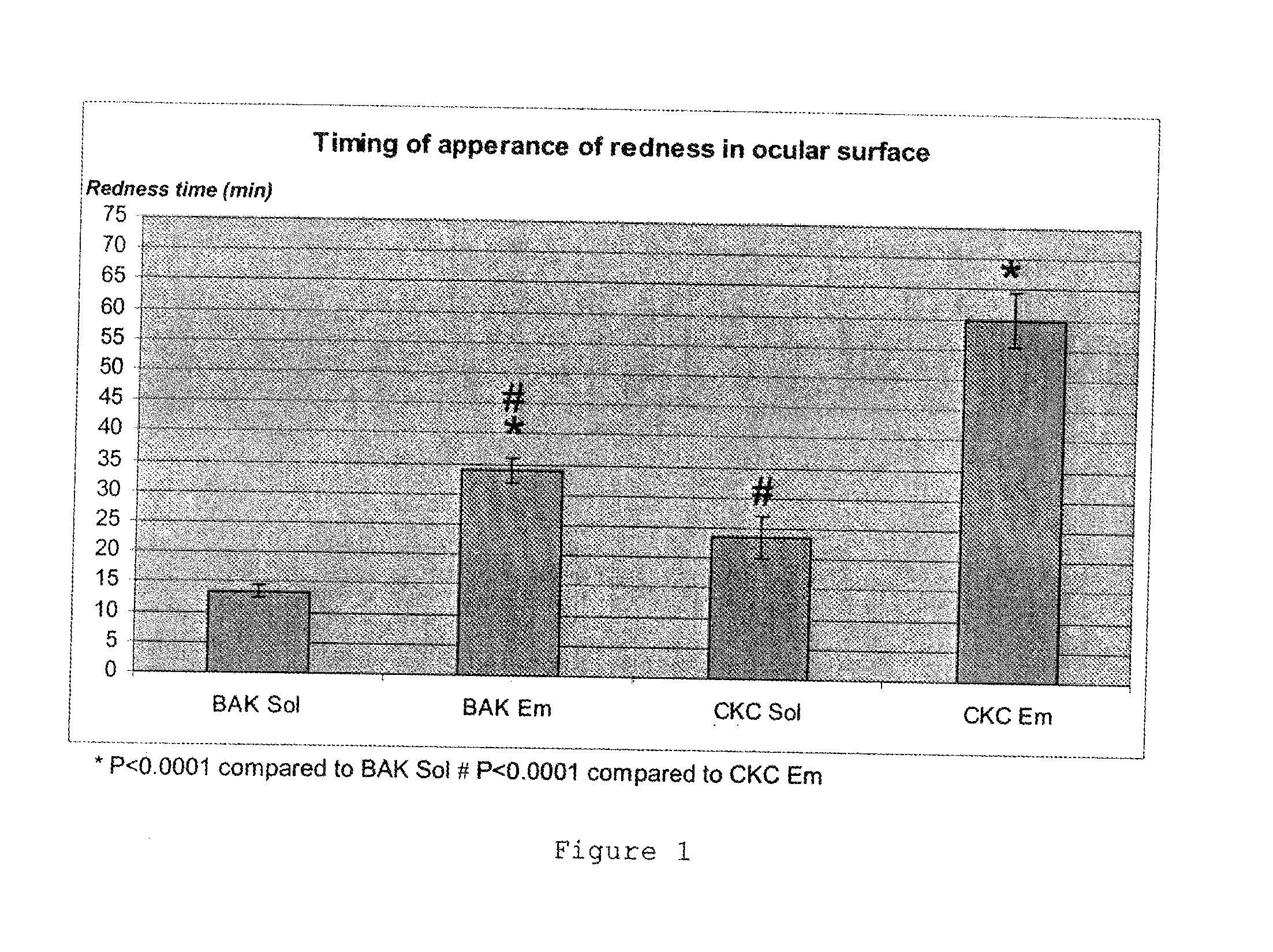Compositions containing quaternary ammonium compounds
- Summary
- Abstract
- Description
- Claims
- Application Information
AI Technical Summary
Benefits of technology
Problems solved by technology
Method used
Image
Examples
example 1
Reduced Toxicity of Quaternary Amines when Incorporated into Emulsions
Materials and Methods
Material
1. Solution at 0.02% BAK (BAK So)
[0099]
ExcipientsZ01SOL472BAK US0.02 NaCl0.612Tris Buffer 5 mM pH 7.10.069% Tris HCl0.006% Tris BaseWaterAd 100
2. Emulsion at 0.02% BAK (BAK Em)
[0100]
ExcipientsZ01EM471Mineral oil heavy0.500Mineral oil light0.500Tyloxapol0.300BAK US0.02 Tris Buffer 5 mM pH 7.10.069% Tris HCl0.006% Tris BasePoloxamer 1880.100Glycerol1.6 Water (up to 100)Ad 100
3. Solution at 0.002% CKC(CKC Sol)
[0101]
ExcipientsZ01SOL473CKC0.002NaCl0.626Tris Buffer 5 mM pH 7.10.069% Tris HCl0.006% Tris baseWaterAd 100
4. Emulsion at 0.002% CKC(CKC Em)
[0102]
ExcipientsZ01EM264Mineral oil heavy0.500Mineral oil light0.500Tyloxapol0.300CKC0.002Tris Buffer 5 mM pH 7.10.069% Tris HCl0.006% Tris BasePoloxamer 1880.100Glycerol1.6 Water (up to 100)Ad 100
5. PBS
Methods:
[0103]Albino rabbits were administrated with 1 drop (50 μl) each 5 minutes, for 15 times.
Results
Evaluation of Toxicity by Time of Redness...
example 2
Stability of the Emulsions of the Invention
1. Emulsions Composition
[0107]Some emulsions are described below:
CompositionZ01EM206Z01EM209MCT 2% 2%Tyloxapol 0.3%0.3%BAK C16 (CKC)0.02%0.025 mMPoloxamer 188 0.1%0.1%Glycerol2.25%2.25% Waterqsp 100qsp 100
CompositionZ01EM419Z01EM264Z01EM387Z01EM418(a)Z01EM418(b)Light mineral oil0.5%0.5% 0.5%0.5%0.5%Heavy mineral oil0.5%0.5% 0.5%0.5%0.5%Tyloxapol0.3%0.3% 0.3%0.3%0.3%Poloxamer 1880.1%0.1%———PG——0.19%——PEG 300——0.19%——PEG 400——0.19%——Mannitol3.3%— 2%2.5%2.9%Glycerol—1.6%0.19%0.19% —Cetalkonium0.002%0.002%0.002% 0.002% 0.002% chloride (CKC)Tromethamine0.006%0.006%———Tris HCl0.071%0.071%———WaterUp to 100%Up to 100%Up to 100%Up to 100%Up to 100%
CompositionZ01EM393-4Z01EM395-6MCT1-2%1-2%Tyloxapol0.3%0.3%PG0.4%—Mannitol—0.9%Glycerol 1% 1%Cetalkonium0.01% 0.01% chloride (CKC)WaterUp to 100%Up to 100%
2. Emulsions Preparation
[0108]The oily and the water phases of the emulsion, which might contain or not an active principle, may be separately heate...
example 3
Comparison of the Stability of Emulsions Comprising Either CKC or BAK
[0119]The stability of emulsions containing 0.002% w / w of CKC and 0.002% w / w of BAK was compared. Compared emulsions have following compositions:
0.002% CKC emulsion0.002% BAK emulsionLight mineral oil0.5%0.5%Heavy mineral oil0.5%0.5%CKC0.002%\BAK US\0.002%Tyloxapol0.3%0.3%Poloxamer 1880.1%0.1%Glycerol1.6%1.6%Tris buffer 5 mM pH0.071% Tris HCl0.071% Tris HCl7.10.006% Tris Base0.006% Tris BaseWaterup to 100%up to 100%
[0120]The zeta potential of the two emulsions was followed overtime using thermal stress test conditions. Thermal stress tests enable to accelerate commonly used stability tests. In the thermal stress test used therein, zeta potential of the emulsion was measured at T=0, i.e. as soon as the emulsion has been prepared. Glass vials of 10 mL effective capacity containing 5-10 mL of emulsion and sealed under nitrogen atmosphere were stored at 80° C. Then, at T=7 days and 14 days, the zeta potential was measu...
PUM
| Property | Measurement | Unit |
|---|---|---|
| Fraction | aaaaa | aaaaa |
| Fraction | aaaaa | aaaaa |
| Fraction | aaaaa | aaaaa |
Abstract
Description
Claims
Application Information
 Login to View More
Login to View More - R&D
- Intellectual Property
- Life Sciences
- Materials
- Tech Scout
- Unparalleled Data Quality
- Higher Quality Content
- 60% Fewer Hallucinations
Browse by: Latest US Patents, China's latest patents, Technical Efficacy Thesaurus, Application Domain, Technology Topic, Popular Technical Reports.
© 2025 PatSnap. All rights reserved.Legal|Privacy policy|Modern Slavery Act Transparency Statement|Sitemap|About US| Contact US: help@patsnap.com



